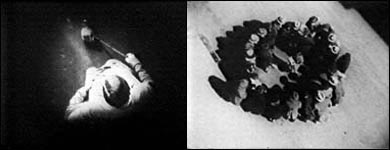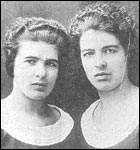
The women’s love in Mulholland Drive
is perfectly surreal in its absolute character, wonder and
violence. Surreal eroticism particularly personifies cultural
dissidence. Surrealist love repels the bourgeois sexual ideology
of repression and reproduction. In L’Age d’Or, the
amour fou of the lovers is constantly obstructed by
a bizarre and corrupt bourgeois society. In Un Chien Andalou,
the beautiful, young androgynous woman is punished and killed
- by car accident - for expressing her erotic fascination
with a severed hand. As seen throughout his films, Lynch also
frequently portrays love as absolute, extreme and culturally
dissident. The absolute, positive passion of Wild At Heart’s
lovers oppose a corrupt, mad matriarch. Even the sadist Frank’s
negative passion for Dorothy which expresses a perverse, dystopian
desire for absolute maternal love is absolutely surreal. The
love affairs of both the innocent and defiled are surreal
as surrealism deals in mythic polarities of darkness and light
and exalts absolute otherness.
| |
 |
|
|
Mulholland Drive identifies women
with mad love and violence. Their love exists despite bizarre,
corrupt Hollywood as it is also destroyed by its weird hegemony.
In surrealism, it is primarily a young heroine however who
embodies cultural dissidence. Idealising women as poetic and
pathological, the surrealists particularly granted women the
erotic, emancipatory power to subvert patriarchy. The Surrealists
are indeed famed for celebrating female criminals such as
Violette Nozière who murdered her father and the Papin sisters,
two maids who murdered their employer. Female violence was
particularly fetishised by the movement. Ultimately, sexuality
is bound up with violence in the Surrealist imagination. In
Mulholland Drive, the victim of love and Hollywood
becomes the executioner of her beloved. Mulholland
Drive’s extraordinary love affair expresses the surrealist
philosophy of love where overpowering sexual desire invariably
leads to the destruction and death of both lover and beloved.
The vision of Diane’s rotting corpse surreally, and horrifically,
exposes the disintegration of erotic desire.
As we have seen above, Baudelaire
exalts in his ode to Lesbos the extra-moral quality
of lesbian love, a love beyond good and evil. As André Breton
indeed reminds us that “Baudelaire est surréaliste dans
la morale” [“Baudelaire is morally surrealist”]
(30) The erotic and marvellous quality of the lesbian lover
in Mulholland Drive as well as her amoral or extra-moral
quality thus mark her as both modernist and surrealist. Morally
subversive eroticism and absolute romance dominate Mulholland
Drive. Lynch’s dualist poetic vision also portrays lesbian
love as both marvellous and dark. In both Lynch’s modern and
surreal characterisation of lesbian love, the lovers experience
absolute desire and destruction.
|